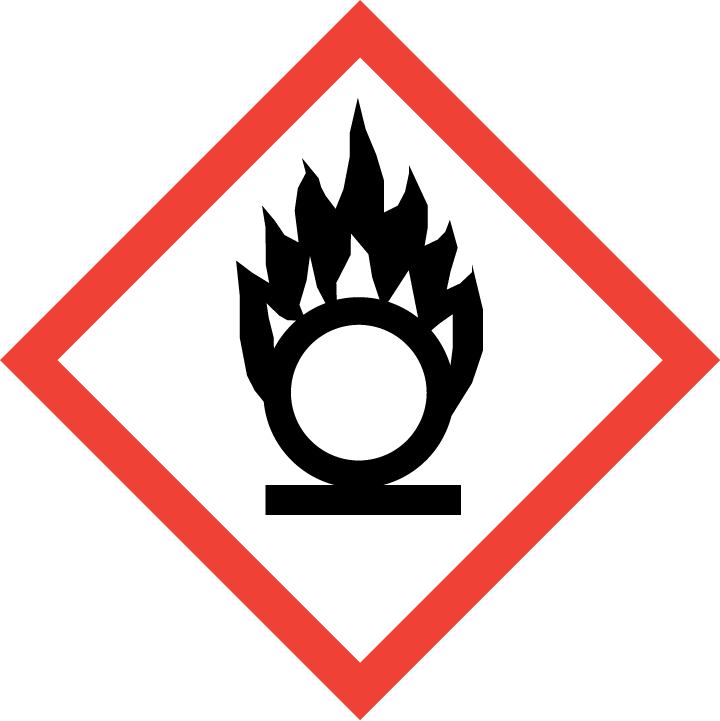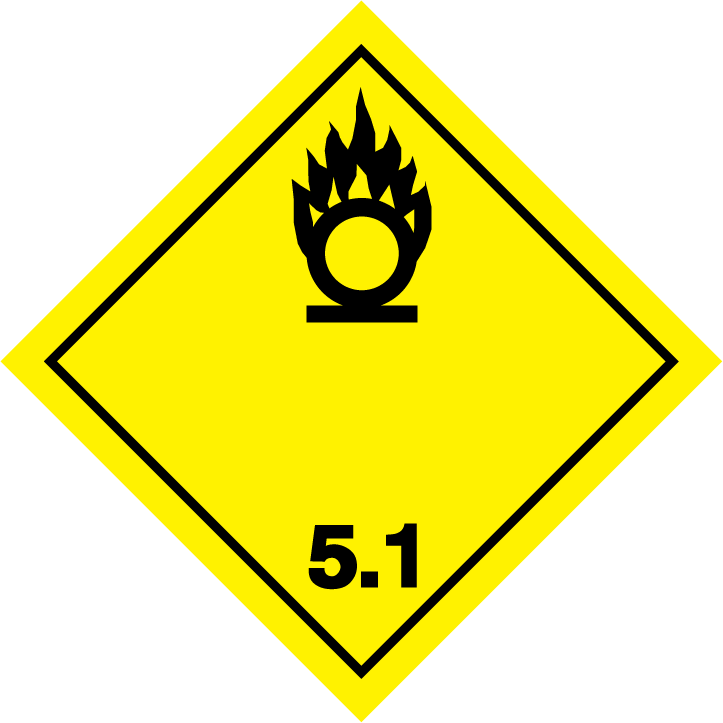SAFETY DATA SHEET
Lanthanum Nitrate
1. IDENTIFICATION
Product Identifiers
Product Name:
Lanthanum Nitrate
Other Names:
N/A
Product Number(s):
EMS17300
CAS Number:
10277-43-7
Recommended use of the chemical and restriction on use
Laboratory use.
Company Details
ProSciTech Pty Ltd
11 Carlton Street
KIRWAN QLD 4817
Australia(07) 4773 9444www.proscitech.com
11 Carlton Street
KIRWAN QLD 4817
Australia(07) 4773 9444www.proscitech.com
Emergency Contact Details
ProSciTech Pty Ltd
11 Carlton Street
KIRWAN QLD 4817
Australia(07) 4773 9444www.proscitech.com
11 Carlton Street
KIRWAN QLD 4817
Australia(07) 4773 9444www.proscitech.com
2. HAZARDS IDENTIFICATION
Classification of the substance or mixture
GHS03 Flame over circle
Oxidizing Solids 2 H272 May intensify fire; oxidiser.
GHS07
Acute Toxicity - Oral 4 H302 Harmful if swallowed.
Acute Toxicity - Dermal 4 Harmful in contact with skin.
Acute Toxicity - Inhalation 4 H332 Harmful if inhaled.
Eye irritation 2B H320 Causes eye irritation.
Oxidizing Solids 2 H272 May intensify fire; oxidiser.
GHS07
Acute Toxicity - Oral 4 H302 Harmful if swallowed.
Acute Toxicity - Dermal 4 Harmful in contact with skin.
Acute Toxicity - Inhalation 4 H332 Harmful if inhaled.
Eye irritation 2B H320 Causes eye irritation.
Label Elements


Signal Words
Danger
Hazard Statement(s)
Hazard-determining components of labelling: Lanthanum Nitrate Hexahydrate.
May intensify fire; oxidiser.
Harmful if swallowed, in contact with skin or if inhaled.
Causes eye irritation.
May intensify fire; oxidiser.
Harmful if swallowed, in contact with skin or if inhaled.
Causes eye irritation.
Precautionary Statement(s)
Keep away from heat.
Keep/store away from clothing/combustible materials.
Take any precaution to avoid mixing with combustibles.
Avoid breathing dust/fume/gas/mist/vapours/spray.
Wash thoroughly after handling.
Do not eat, drink or smoke when using this product.
Use only outdoors or in a well-ventilated area.
Wear protective gloves/protective clothing/eye protection/face protection.
Keep/store away from clothing/combustible materials.
Take any precaution to avoid mixing with combustibles.
Avoid breathing dust/fume/gas/mist/vapours/spray.
Wash thoroughly after handling.
Do not eat, drink or smoke when using this product.
Use only outdoors or in a well-ventilated area.
Wear protective gloves/protective clothing/eye protection/face protection.
Primary route(s) of entry
Not available.
Human Health
Inhalation:
Remove person to fresh air and keep comfortable for breathing. Call a POISON CENTER/doctor if you feel unwell.
Ingestion:
Rinse mouth.
Eyes:
Rinse cautiously with water for several minutes. Remove contact lenses, if present and easy to do. Continue rinsing. Specific treatment (see on this label)
If eye irritation persists: Get medical advice/attention.
If eye irritation persists: Get medical advice/attention.
Skin:
Take off contaminated clothing and wash it before reuse.
Environment
In case of fire: Use CO₂, powder or water spray to extinguish.
Store in a well-ventilated place. Keep cool.
Store away for oxidising agents.
Dispose of contents/container in accordance with local/regional/national/international regulations.
Store in a well-ventilated place. Keep cool.
Store away for oxidising agents.
Dispose of contents/container in accordance with local/regional/national/international regulations.
3. COMPOSITION/INFORMATION ON INGREDIENTS
Name
CAS No.
Content (w/w)
Classification
Lanthanum Nitrate Hexahydrate
10277-43-7
-
-
4. FIRST AID MEASURES
Ingestion
Immediately call a doctor.
Inhalation
Supply fresh air. If required, provide artificial respiration. Keep patient warm. Consult doctor if symptoms persist.
In case of unconsciousness place patient stably in side position for transportation.
In case of unconsciousness place patient stably in side position for transportation.
Skin Contact
Generally the product does not irritate the skin.
Eye Contact
Rinse opened eye for several minutes under running water. If symptoms persist, consult a doctor.
Other Information
Symptoms of poisoning may even occur after several hours; therefore medical observation for at least 48 hours after the accident.
5. FIREFIGHTING MEASURES
Suitable extinguishing equipment
CO₂, powder or water spray. Fight larger fires with water spray or alcohol resistant foam.
HAZCHEM
Not available.
Special protective equipment and precautions for fire fighters
6. ACCIDENTAL RELEASE MEASURES
Personal precautions, protective equipment and emergency procedures
Not required.
Environmental precautions
Do not allow to enter sewers/ surface or ground water.
Methods and materials for containment and clean up
Dispose contaminated material as waste according to item 13.
Ensure adequate ventilation.
Ensure adequate ventilation.
7. HANDLING AND STORAGE
Precautions for safe handling
Thorough dedusting.
Ensure good ventilation/exhaustion at the workplace.
Ensure good ventilation/exhaustion at the workplace.
Conditions for safe storage
Store in a well-ventilated place.
Keep container tightly sealed.
Protect from heat and direct sunlight.
8. EXPOSURE CONTROLS/PERSONAL PROTECTION
Exposure Standards
Engineering controls
Not available.
Personal protective equipment
Eye and face protection
Tightly sealed goggles.
Skin protection
Protective gloves
The glove material has to be impermeable and resistant to the product/ the substance/ the preparation.Due to missing tests no recommendation to the glove material can be given for the product/ the preparation/ the chemical mixture.
Selection of the glove material on consideration of the penetration times, rates of diffusion and the degradation.
Material of glove.
The selection of the suitable gloves does not only depend on the material, but also on further marks of quality and varies from manufacturer to manufacturer.
Penetration time of glove material.
The exact break through time has to be found out by the manufacturer of the protective gloves and has to be observed.
The glove material has to be impermeable and resistant to the product/ the substance/ the preparation.Due to missing tests no recommendation to the glove material can be given for the product/ the preparation/ the chemical mixture.
Selection of the glove material on consideration of the penetration times, rates of diffusion and the degradation.
Material of glove.
The selection of the suitable gloves does not only depend on the material, but also on further marks of quality and varies from manufacturer to manufacturer.
Penetration time of glove material.
The exact break through time has to be found out by the manufacturer of the protective gloves and has to be observed.
Body protection
Keep away from foodstuffs, beverages and feed.
Immediately remove all soiled and contaminated clothing.
Wash hands before breaks and at the end of work.
Avoid contact with the eyes.
Avoid contact with the eyes and skin.
Immediately remove all soiled and contaminated clothing.
Wash hands before breaks and at the end of work.
Avoid contact with the eyes.
Avoid contact with the eyes and skin.
Respiratory protection
In case of brief exposure or low pollution use respiratory filter device. In case of intensive or longer exposure use self-contained respiratory protective device.
9. PHYSICAL AND CHEMICAL PROPERTIES
General information
Appearance
Colourless crystals.
Odour
Odourless
pH
Not applicable.
Vapour Pressure
Not applicable.
Density
Not determined.
Boiling Point
Undetermined.
Melting Point
40 °C
Solubility
Soluble in water.
Specific Gravity of Density
Not determined.
Flash Point
Not applicable.
Flammable (Explosive) Limits
Not determined.
Ignition Temperature
Not determined.
Formula
La(NO3)36H2O
10. STABILITY AND REACTIVITY
Reactivity
No further relevant information available.
Chemical stability
No decomposition if used according to specifications.
Possibility of hazardous reactions
No dangerous reactions known.
Conditions to avoid
No further relevant information available.
Incompatible materials
No further relevant information available.
11. TOXICOLOGICAL INFORMATION
Acute effects
No further relevant information available.
Eye contact
Irritating effect.
Skin contact
Irritant to skin and mucous membranes.
Ingestion
No further relevant information available.
Inhalation
No sensitising effects known.
Toxicity and irritation
No further relevant information available.
12. ECOLOGICAL INFORMATION
Ecotoxicity
No further relevant information available.
Persistence and degradability
No further relevant information available.
Bioaccumulative potential
No further relevant information available.
Other adverse effects
Water hazard class 1 (German Regulation) (Self-assessment): slightly hazardous for water Do not allow undiluted product or large quantities of it to reach ground water, water course or sewage system.
13. DISPOSAL CONSIDERATIONS
General information
Must not be disposed together with household garbage. Do not allow product to reach sewage system
.Uncleaned packaging:
Recommendation: Disposal must be made according to official regulations.
.Uncleaned packaging:
Recommendation: Disposal must be made according to official regulations.
14. TRANSPORT INFORMATION
ADG label required

HAZCHEM
Not available.
UN Number
UN1477
Proper shipping name
477 NITRATES, INORGANIC, N.O.S.
Transport hazard class
5.1 Oxidizing substances
Packing group
II
Environmental hazard
No
Special precautions for users
Warning: Oxidising substances
EMS Number: F-A
Stowage Category: A
Segregation Code:
SG38 Stow "separated from" SGG2-ammonium compounds.
SG49 Stow "separated from" SGG6-cyanides.
EMS Number: F-A
Stowage Category: A
Segregation Code:
SG38 Stow "separated from" SGG2-ammonium compounds.
SG49 Stow "separated from" SGG6-cyanides.
Additional information
IMDG
Limited quantities (LQ) 1 kg
Excepted quantities (EQ) Code: E2
Maximum net quantity per inner packaging: 30 g
Maximum net quantity per outer packaging: 500 g
DOT
Quantity limitations:
On passenger aircraft/rail: 5kg
On cargo aircraft only: 25kg
Limited quantities (LQ) 1 kg
Excepted quantities (EQ) Code: E2
Maximum net quantity per inner packaging: 30 g
Maximum net quantity per outer packaging: 500 g
DOT
Quantity limitations:
On passenger aircraft/rail: 5kg
On cargo aircraft only: 25kg
15. REGULATORY INFORMATION
Poisons Schedule Number
Substance is not listed.
Other Information
No further relevant information available.
16. OTHER INFORMATION
SDS preparation date
16 August 2023
Comments
This information is based on our present knowledge. However, this shall not constitute a guarantee for any specific product features and shall not establish a legally valid contractual relationship.
This Safety Data Sheet (SDS) has been prepared in compliance with the Preparation of Safety Data Sheets for Hazardous Chemicals Code of Practice February 2016. It is the user's responsibility to determine the suitability of this information for adoption of necessary safety precautions. The information published in this SDS has been compiled from the publications listed in Section 16: to the best of our ability and knowledge these publications are considered accurate. We reserve the right to revise Safety Data Sheets as new information becomes available. Copies may be made for non-profit use.